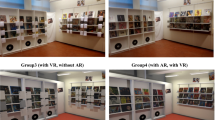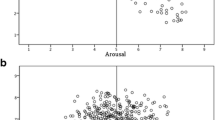Abstract
A common measure of effectiveness of a virtual environment (VE) is the amount of presence it evokes in users. Presence is commonly defined as the sense of being there in a VE. There has been much debate about the best way to measure presence, and presence researchers need and have sought a measure that is reliable, valid, sensitive, and objective. We hypothesized that to the degree that a VE seems real, it would evoke physiological responses similar to those evoked by the corresponding real environment, and that greater presence would evoke a greater response. To examine this, we conducted four experiments, each of which built upon findings that physiological measures in general, and heart rate in particular, are reliable, valid, sensitive, and objective presence measures. The experiments compare participants’ physiological reactions to a nonthreatening virtual room and their reactions to a stressful virtual height situation. We found that change in heart rate satisfied our requirements for a measure of presence, change in skin conductance did to a lesser extent, and that change in skin temperature did not. Moreover, the results showed that significant increases in heart rate measures of presence appeared with the inclusion of a passive haptic element in the VE, with increasing frame rate (30 FPS > 20 FPS > 15 FPS) and when end-to-end latency was reduced (50 ms > 90 ms).
Similar content being viewed by others
References
Abelson, J. L., & Curtis, G. C. (1989). Cardiac and neuroendocrine responses to exposure therapy in height phobics. Behavior Research and Therapy, 27(5), 561–567.
Andreassi, J. L. (1995). Psychophysiology: Human behavior and physiological response. Hillsdale, NJ: Erlbaum.
Cowings, P., Jensen, S., Bergner, D., & Toscano, W. (2001). A lightweight ambulatory physiological monitoring system. California: NASA Ames.
Dillon, C., Keogh, E., Freeman, J., & Davidoff, J. (2001). Presence: Is your heart in it?. 4th International Workshop on Presence, Philadelphia.
Ellis, S. R. (1996). Presence of mind: A reaction to Thomas Sheridan’s “Further musings on the psychophysics of presence.” Presence: Teleoperators and Virtual Environments, 5(2), 247–259.
Emmelkamp, P., & Felten, M. (1985). The process of exposure in vivo: Cognitive and physiological changes during treatment of acrophobia. Behavior Research and Therapy, 23(2), 219.
Guyton, A. C. (1986). Textbook of medical physiology (pp. 688–697). Philadelphia, PA: W.B. Saunders.
Heeter, C. (1992). Being there: The subjective experience of presence. Presence: Teleoperators and Virtual Environments, 1, 262–271.
Hodges, L., Rothbaum, B., Kooper, R., Opdyke, D., Willford, J., Meyer, T., et al. (1994). Presence as the defining factor in a VR application. Technical Report GVU-94-06. Georgia Tech University, Graphics, Visualization, and Usability Center.
Kleinbaum, D., Kupper, L., Muller, K., & Nizam, A. (1998). Applied regression analysis and other multivariate methods (3rd ed.). Pacific Grove, CA: Duxbury Press.
Lipsey, M. W. (1998). Design sensitivity: Statistical power for applied experimental research. In L. Brickman & D. J. Rog (Eds.), Handbook of applied social research methods (pp. 39–68). Thousand Oaks, CA, Sage.
Lombard, M., & Ditton, T. (1997). At the heart of it all: The concept of presence. Journal of Computer Mediated Communication, 3(2). Available at: http://www.ascusc.org/jcmc/vol3/issue2/lombard.html
Meehan, M. (2001). Physiological reaction as an objective measure of presence in virtual environments. Doctoral dissertation, Computer Science, University of North Carolina, Chapel Hill, NC.
Meehan, M., Insko, B., Whitton, M., & Brooks, F. P. (2002). Physiological measures of presence in stressful virtual environments. In Proceedings of ACM SIGGRAPH 2002.
Meehan, M., Razzaque, S., Whitton, M., & Brooks, F. (2003). Effects of latency on presence in stressful virtual environments. Proceedings of IEEE Virtual Reality 2003 (Los Angeles, CA, March 2003) (pp. 141–148). IEEE Computer Society.
Schubert, T. (2003). The sense of presence in virtual environments: A three-component scale measuring spatial presence, involvement, and realness. Zeitschrift für Medienpsychologie, 15, 69–71.
Sheridan, T. B. (1996). Further musings on the psychophysics of presence. Presence: Teleoperators and Virtual Environments, 5(2), 241–246.
Singleton, R. A., Straits, B. C., & Straits, M. M. (1993). Approaches to Social Research. New York, Oxford University Press.
Slater, M. (1999). Measuring Presence: A Response to the Witmer and Singer Presence Questionnaire. Presence: Teleoperators and Virtual Environments, 8(5), 560–565.
Slater, M., Usoh, M., & Steed, A. (1994). Depth of presence in virtual environments. Presence: Teleoperators and Virtual Environments, 3(2), 130–144.
Slater, M., Usoh, M., & Steed, A. (1995). Taking steps: The influence of a walking technique on presence in virtual reality. ACM Transactions on Computer Human Interaction (TOCHI), 2(3), 201–219.
Slater, M., & Steed, A. J. (2000) A virtual presence counter, Presence: Teleoperators and Virtual Environments, 9(5), 413–434.
Slater, M. (2003). How colourful was your day? Why questionnaires cannot assess presence in virtual environments. Presence: Teleoperators and Virtual Environments, 13(4), 484–493.
Slonim, N. B. (Ed.). (1974). Environmental physiology. Saint Louis: C. V. Mosby.
Sutherland, S. (1996). The international dictionary of psychology. New York: The Crossroads.
Usoh, M., Arthur, K., Whitton, M., Bastos, R., Steed, A., Slater, M., et al. (1999). Walking > walking-in-place > flying in virtual environments. Proceedings of ACM SIGGRAPH99. pp. 359–364.
Weiderhold, B. K., Gervirtz, R., & Wiederhold, M. D. (1998). Fear of flying: A case report using virtual reality therapy with physiological monitoring. CyberPsychology and Behavior, 1(2), 97–104.
Witmer, B. G., & Singer, M. J. (1998). Measuring presence in virtual environments: A presence questionnaire. Presence: Teleoperators and Virtual Environments, 7(3), 225–240.
Author information
Authors and Affiliations
Corresponding author
Rights and permissions
About this article
Cite this article
Meehan, M., Razzaque, S., Insko, B. et al. Review of Four Studies on the Use of Physiological Reaction as a Measure of Presence in StressfulVirtual Environments. Appl Psychophysiol Biofeedback 30, 239–258 (2005). https://doi.org/10.1007/s10484-005-6381-3
Issue Date:
DOI: https://doi.org/10.1007/s10484-005-6381-3




